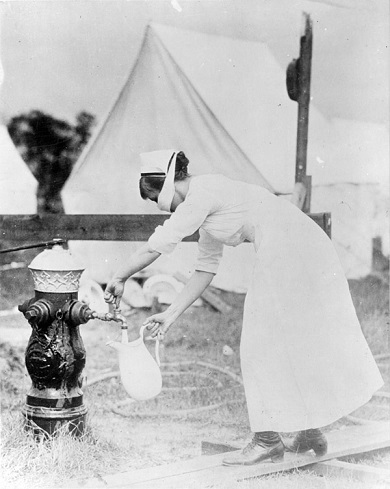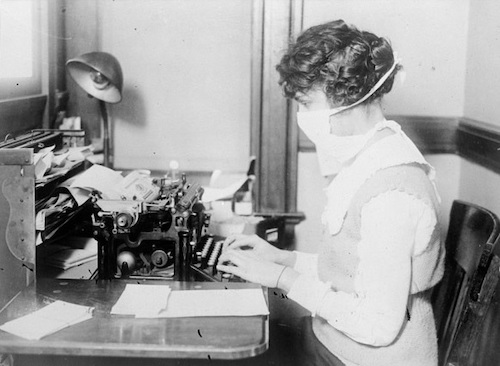The Chronicles Of Grant County
Impact of Influenza
 A nurse wearing a mask to get water on September 13, 1918. (The photo was provided courtesy of the National Archives and Records Administration.)
A nurse wearing a mask to get water on September 13, 1918. (The photo was provided courtesy of the National Archives and Records Administration.)
Influenza is now a daily news story for many Americans. The “regular” flu season is well underway. Each year, many Americans get sick and a number die annually from the flu.
But today, there is now a looming influenza that may or may not have substantial impact in the United States. As of today, there are no definitive statistics on key facets of Covid 19, the new coronavirus. Scientists do not yet have firm details on the extent of the spread of this virus as well as its mortality rate. Leaders have confirmed that someone could have Covid 19, show no symptons of the disease, and be contagious to others.
In the meantime, the “regular” influenza is impacting communities throughout New Mexico and our country.
In years past, Grant County had to deal with influenza that caused devastation locally as well as throughout the world during 1918 and 1919.
It was a time when government officials in New Mexico suspended Constitutional rights that most Americans thought could not be disregarded.
Lives were in jeopardy.
The government determined it had to act swiftly to save people.
Most Americans understood the need for public safety was a reasonable exercise of governmental power in face of an invisible threat that knew no boundaries.
Silver City was no exception.
According to The Public Schools of Silver City (New Mexico), compiled by Ms. Helen Calkins, the schools in Silver City were closed on October 11, 1918, “by order of County Physician, Dr. C. S. Guthrey.” Schools remained closed until January 6, 1919.
The book details that for some time period there were no public gatherings in Silver City for fear that the influenza would spread further among the local population.
Several news reports noted that a number of people living in camp at Mogollon were sickened and died because of the influenza at this time. The specific number of those who got ill and the number of deaths at Mogollon has not been found.
The impact of this influenza on the Native American population in New Mexico was especially devastating.
According to a report by the Idaho Department of Health and Welfare, statistics from the Federal government highlight the impact in a number of states. A graph showed that between October of 1918 and June of 1919, about half of all Native Americans in New Mexico had contracted influenza.
Of the 10,971 Native Americans in New Mexico who had influenza, the Federal government reported that 1,245 died.
The mortality rate for this influenza was 11.3% among Native Americans in New Mexico. The mortality rate was the same in Arizona among Native Americans.
While mortality levels were even higher among Native Americans in Colorado, Florida, Idaho, and Utah, the actual number of Native Americans who died from influenza during this time period was highest in Arizona (1,948 Native Americans died) and in New Mexico itself.
On October 16, 1918, the City Commission and the Board of Health of the City of Albuquerque banned all public open air meetings, according to a news article dated October 17, 1918, in the Albuquerque Morning Journal. This included banning religious services, lodge meetings, and any other gatherings of people in one place. People were encouraged not to attend funerals for the dead.
To put the times in perspective, the newspaper reported that as of October 16, 1918, 394 cases of influenza had been reported to health officials in Albuquerque. Of those that had contracted the disease, 34 people had died.
Other communities throughout New Mexico took actions similar to the ones in Silver City and Albuquerque.
Lives were at stake.
The following text appeared on the front page of The Belen News and The Valencia Standard on October 24, 1918:
“Unprecedented in New Mexico history is the proclamation issued today by Governor W. E. Lindsey urging that not only schools and churches be closed, but also that any gatherings of people, whether in homes or in public places, or even at funerals, be avoided.”
To put the times in perspective, the United States National Archives and Records Administration reported that “The influenza epidemic of 1918 killed more people than died in World War I.” The National Archives estimated that 16 million people died during World War I; about 50 million people throughout the world died from this influenza.
Consider the following statement from the National Archives: “In one year, the average life expectancy in the United States dropped by 12 years.”
The United States Centers for Disease Control and Prevention reported that the virus that caused the pandemic of 1918-1919 continued “to circulate seasonally for 38 years.”
 A typist wearing a mask at work in the City of New York on October 16, 1918. (The photograph was provided courtesy of the National Archives and Records Administration.)
A typist wearing a mask at work in the City of New York on October 16, 1918. (The photograph was provided courtesy of the National Archives and Records Administration.)
Do you have questions about communities in Grant County?
A street name? A building?
Your questions may be used in a future news column.
Contact Richard McDonough at chroniclesofgrantcounty@gmail.com.
© 2020 Richard McDonough